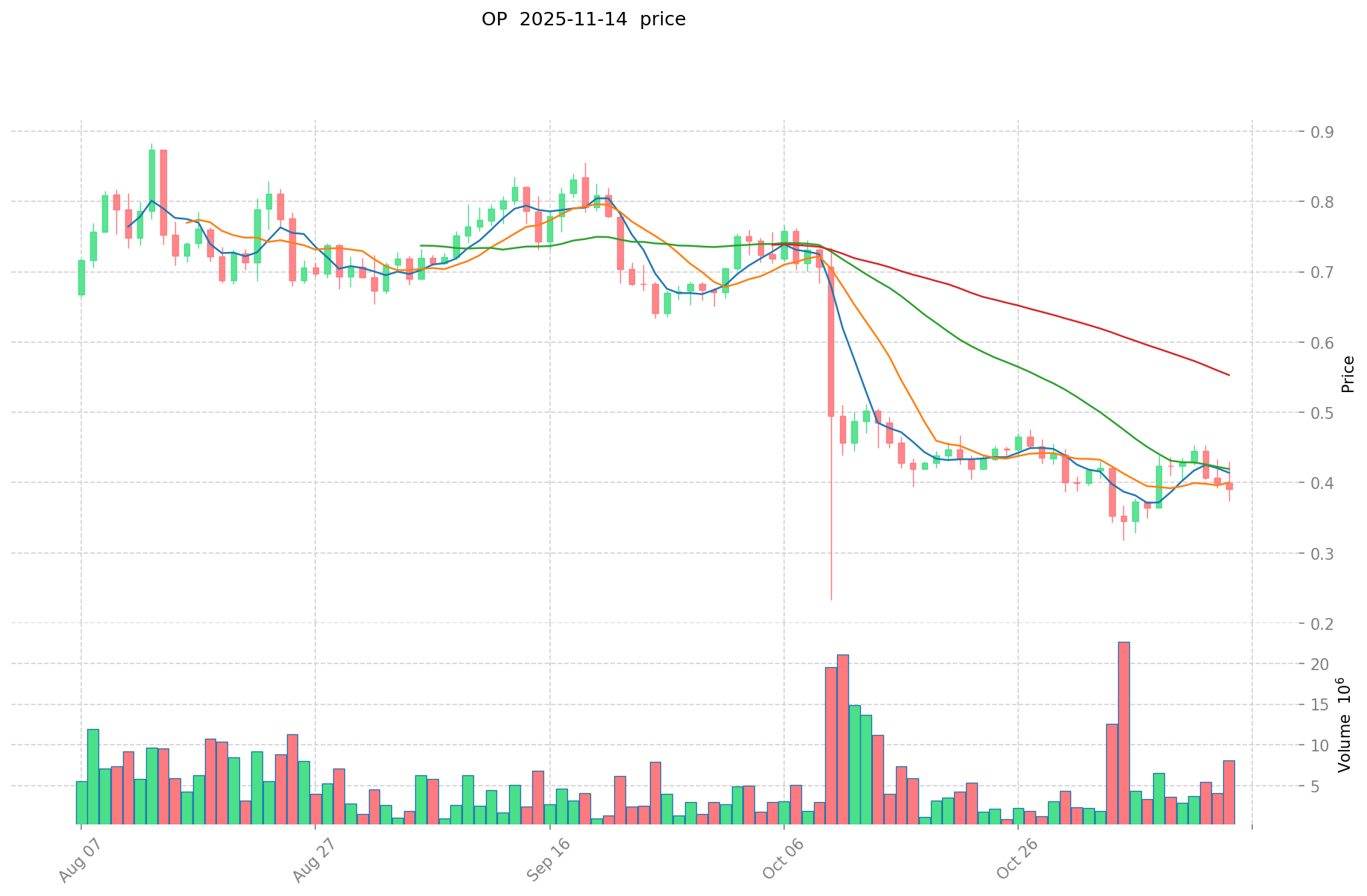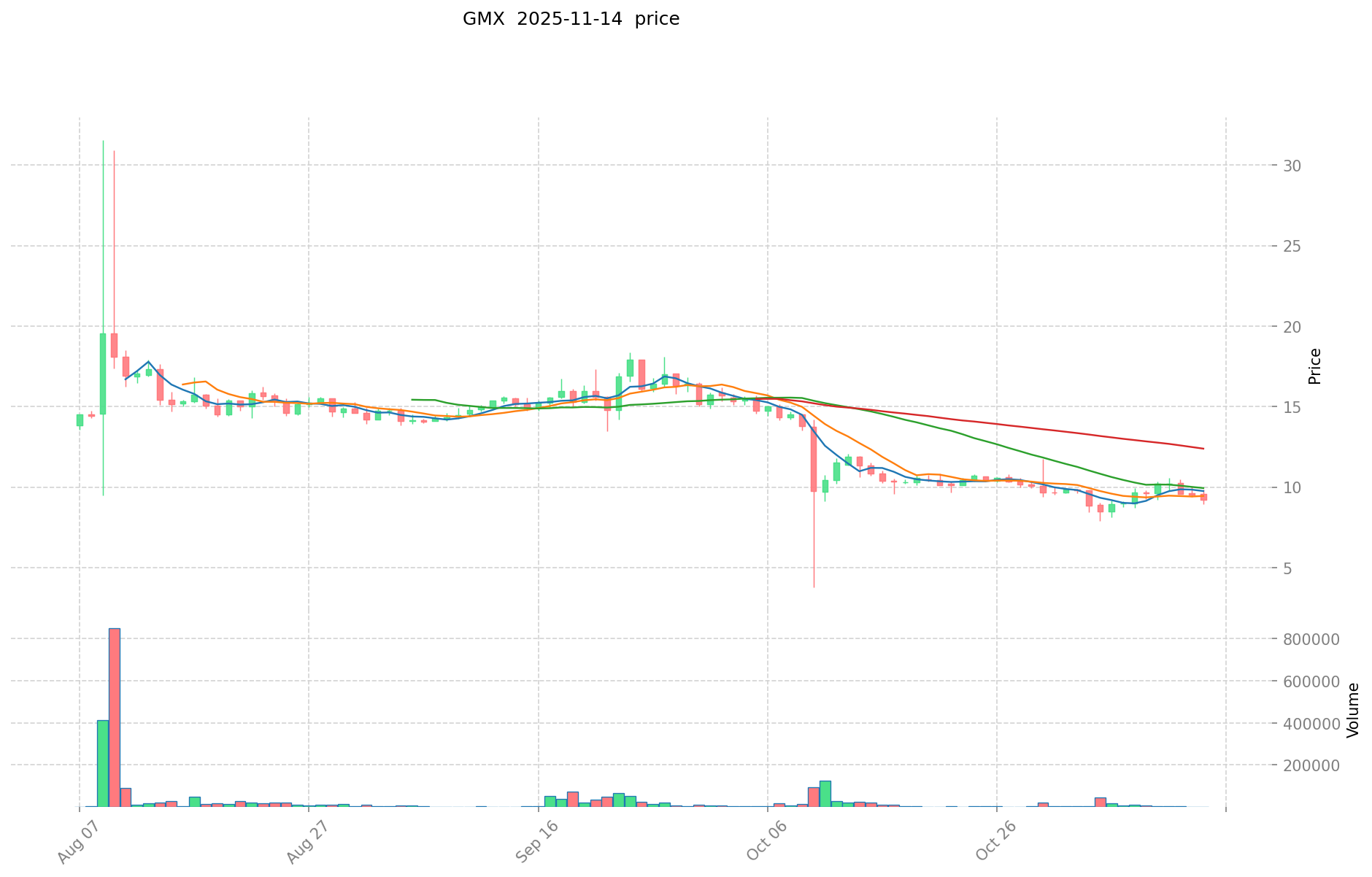OP vs GMX: A Comparative Analysis of Leading DEX Protocols on Ethereum and Optimism
Introduction: Investment Comparison of OP vs GMX
In the cryptocurrency market, the comparison between Optimism (OP) and GMX (GMX) has always been a topic that investors cannot ignore. The two not only differ significantly in market cap ranking, application scenarios, and price performance, but also represent different positions in the crypto asset landscape.
Optimism (OP): Since its launch, it has gained market recognition as a low-cost, lightning-fast Ethereum Layer 2 blockchain solution.
GMX (GMX): Established as a decentralized perpetual exchange, it has been recognized for its utility and governance token model.
This article will comprehensively analyze the investment value comparison between Optimism and GMX, focusing on historical price trends, supply mechanisms, institutional adoption, technical ecosystems, and future predictions, attempting to answer the question investors care about most:
"Which is the better buy right now?"
I. Price History Comparison and Current Market Status
Optimism (OP) and GMX (GMX) Historical Price Trends
- 2024: OP reached its all-time high of $4.84 on March 6, 2024.
- 2025: GMX hit its all-time low of $6.92 on October 11, 2025.
- Comparative Analysis: In the current market cycle, OP has fallen from its peak of $4.84 to $0.3747, while GMX has declined from its all-time high of $91.07 to $8.57.
Current Market Situation (2025-11-15)
- OP current price: $0.3747
- GMX current price: $8.57
- 24-hour trading volume: OP $2,874,747.37 vs GMX $26,280.56
- Market Sentiment Index (Fear & Greed Index): 16 (Extreme Fear)
Click to view real-time prices:
- Check OP current price Market Price
- Check GMX current price Market Price


II. Core Factors Affecting the Investment Value of OP vs GMX
Supply Mechanism Comparison (Tokenomics)
- OP: Optimism uses a governance token model with an initial allocation of 4.29 billion tokens. The token supply is managed through a multi-phase distribution system including an ecosystem fund, retroactive funding, and governance initiatives.
- GMX: GMX features a token with a maximum supply of 13.25 million tokens with deflationary mechanics. 30% of platform fees are used for token buybacks and burns, creating constant deflationary pressure.
- 📌 Historical Pattern: Deflationary models like GMX's tend to create more upward price pressure during bull markets, while governance tokens like OP often see value accrual tied to protocol adoption and revenue.
Institutional Adoption and Market Applications
- Institutional Holdings: GMX has attracted attention from trading firms due to its sustainable fee-based revenue model, while OP has broader institutional backing through Optimism's connections with Ethereum-focused investors and its Collective governance.
- Enterprise Adoption: OP benefits from broader enterprise adoption as many projects build on Optimism, while GMX focuses specifically on decentralized perpetual trading applications.
- Regulatory Attitudes: Derivatives platforms like GMX face more regulatory scrutiny in certain jurisdictions, while layer-2 solutions like Optimism generally face fewer direct regulatory challenges.
Technical Development and Ecosystem Building
- OP Technical Upgrades: Optimism's Bedrock upgrade significantly improved transaction throughput and reduced fees, with further developments through the OP Stack allowing for a modular scaling approach and supporting the Superchain vision.
- GMX Technical Development: GMX v2 brought significant improvements to the trading platform with better capital efficiency, reduced price impact, and more sophisticated market making, while expanding to additional networks.
- Ecosystem Comparison: OP supports a broader ecosystem spanning DeFi, NFTs, gaming, and infrastructure, while GMX focuses specifically on trading with deep liquidity and comprehensive derivatives functionality.
Macroeconomic Factors and Market Cycles
- Performance in Inflationary Environments: GMX's fee-generating model provides revenue regardless of market conditions, potentially offering better protection during inflation.
- Macroeconomic Monetary Policy: Interest rates and dollar strength affect both tokens, but GMX's trading volume can actually increase during high volatility periods.
- Geopolitical Factors: GMX benefits from global demand for decentralized derivatives trading access, while OP benefits from the overall growth of Ethereum's layer-2 ecosystem as global blockchain adoption increases.
III. 2025-2030 Price Prediction: OP vs GMX
Short-term Prediction (2025)
- OP: Conservative $0.25 - $0.38 | Optimistic $0.38 - $0.49
- GMX: Conservative $6.76 - $8.55 | Optimistic $8.55 - $9.24
Mid-term Prediction (2027)
- OP may enter a growth phase, with estimated price range $0.31 - $0.52
- GMX may enter a consolidation phase, with estimated price range $5.44 - $9.85
- Key drivers: Institutional capital inflow, ETF developments, ecosystem growth
Long-term Prediction (2030)
- OP: Base scenario $0.48 - $0.61 | Optimistic scenario $0.61 - $0.84
- GMX: Base scenario $7.04 - $10.51 | Optimistic scenario $10.51 - $13.45
Disclaimer: This analysis is based on historical data and market projections. Cryptocurrency markets are highly volatile and unpredictable. This information should not be considered as financial advice. Always conduct your own research before making investment decisions.
OP:
| 年份 | 预测最高价 | 预测平均价格 | 预测最低价 | 涨跌幅 |
|---|---|---|---|---|
| 2025 | 0.485298 | 0.3762 | 0.252054 | 0 |
| 2026 | 0.56428119 | 0.430749 | 0.36182916 | 14 |
| 2027 | 0.5174156988 | 0.497515095 | 0.31343450985 | 32 |
| 2028 | 0.619107784218 | 0.5074653969 | 0.35522577783 | 35 |
| 2029 | 0.66467817685962 | 0.563286590559 | 0.54638799284223 | 50 |
| 2030 | 0.841155865681754 | 0.61398238370931 | 0.478906259293261 | 63 |
GMX:
| 年份 | 预测最高价 | 预测平均价格 | 预测最低价 | 涨跌幅 |
|---|---|---|---|---|
| 2025 | 9.23832 | 8.554 | 6.75766 | 0 |
| 2026 | 9.8747376 | 8.89616 | 7.3838128 | 3 |
| 2027 | 9.85472124 | 9.3854488 | 5.443560304 | 9 |
| 2028 | 10.4858926718 | 9.62008502 | 7.5036663156 | 12 |
| 2029 | 10.957757842031 | 10.0529888459 | 6.836032415212 | 17 |
| 2030 | 13.44687788027584 | 10.5053733439655 | 7.038600140456885 | 22 |
IV. Investment Strategy Comparison: OP vs GMX
Long-term vs Short-term Investment Strategy
- OP: Suitable for investors focused on Layer 2 scaling solutions and ecosystem growth potential
- GMX: Suitable for investors seeking exposure to decentralized derivatives trading and fee-generating protocols
Risk Management and Asset Allocation
- Conservative investors: OP: 30% vs GMX: 70%
- Aggressive investors: OP: 60% vs GMX: 40%
- Hedging tools: Stablecoin allocation, options, cross-token portfolios
V. Potential Risk Comparison
Market Risk
- OP: Highly dependent on Ethereum's success and adoption of Layer 2 solutions
- GMX: Vulnerable to volatility in trading volumes and overall crypto market sentiment
Technical Risk
- OP: Scalability challenges, network stability during high congestion periods
- GMX: Smart contract vulnerabilities, liquidity risks in extreme market conditions
Regulatory Risk
- Global regulatory policies may have different impacts on layer 2 solutions (OP) versus decentralized derivatives platforms (GMX)
VI. Conclusion: Which Is the Better Buy?
📌 Investment Value Summary:
- OP advantages: Broader ecosystem support, potential for mass adoption of Layer 2 solutions
- GMX advantages: Sustainable fee-based revenue model, deflationary tokenomics
✅ Investment Advice:
- New investors: Consider a balanced approach, leaning towards OP for its broader market exposure
- Experienced investors: Explore GMX for its unique value proposition in decentralized derivatives
- Institutional investors: Evaluate OP for long-term ecosystem growth, GMX for potential yield generation
⚠️ Risk Warning: Cryptocurrency markets are highly volatile. This article does not constitute investment advice. None
VII. FAQ
Q1: What are the main differences between OP and GMX? A: OP is a Layer 2 scaling solution for Ethereum, while GMX is a decentralized perpetual exchange. OP focuses on broader ecosystem development, while GMX specializes in derivatives trading.
Q2: Which token has performed better historically? A: Based on the provided data, OP reached its all-time high of $4.84 in March 2024, while GMX hit its all-time low of $6.92 in October 2025. However, past performance does not guarantee future results.
Q3: How do the tokenomics of OP and GMX differ? A: OP has a governance token model with an initial allocation of 4.29 billion tokens. GMX has a maximum supply of 13.25 million tokens with deflationary mechanics, including token buybacks and burns.
Q4: Which token is more suitable for long-term investment? A: OP may be more suitable for long-term investors focused on Layer 2 scaling solutions and ecosystem growth potential. GMX might appeal to those seeking exposure to decentralized derivatives trading and fee-generating protocols.
Q5: What are the main risks associated with investing in OP and GMX? A: For OP, risks include dependency on Ethereum's success and adoption of Layer 2 solutions. For GMX, risks include vulnerability to trading volume volatility and potential regulatory challenges for decentralized derivatives platforms.
Q6: How do institutional adoptions differ between OP and GMX? A: OP has broader institutional backing through Optimism's connections with Ethereum-focused investors. GMX has attracted attention from trading firms due to its sustainable fee-based revenue model.
Q7: What are the price predictions for OP and GMX in 2030? A: According to the provided predictions, OP's price range for 2030 is estimated at $0.48 - $0.84, while GMX's range is projected at $7.04 - $13.45. However, these are speculative and should not be considered financial advice.
Share
Content